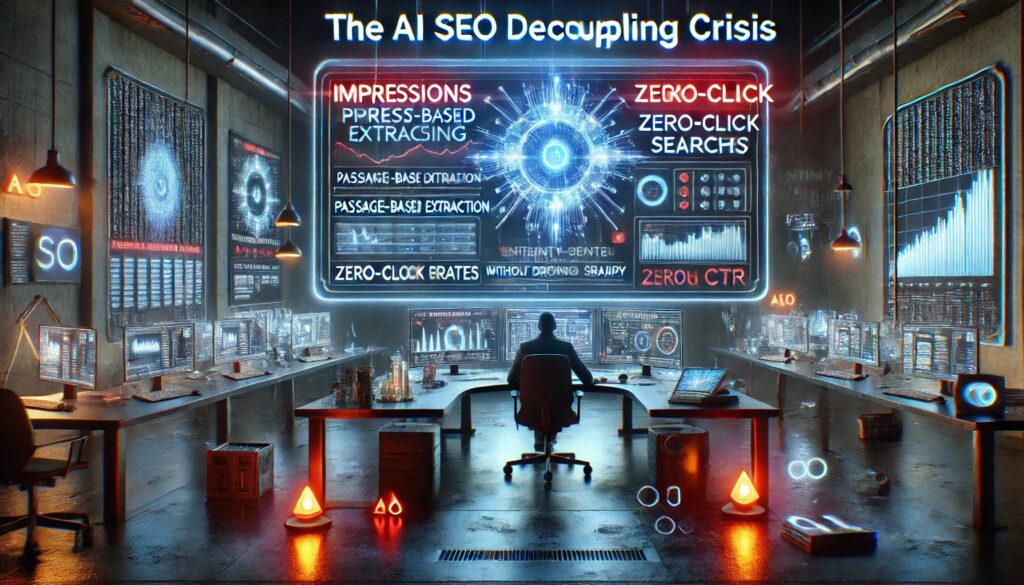
Your impressions just hit an all-time high. Your click-through rates just hit an all-time low.
Welcome to the AI SEO Decoupling Crisis—the moment when twenty years of SEO fundamentals broke apart like a badly designed algorithm.
After managing SEO campaigns through every major Google update since 2015, I’ve never seen anything like what’s happening right now. The rules that governed digital marketing for two decades are being rewritten in real-time by AI systems that view your content as raw material for their own answers.
This isn’t just another algorithm update. This is algorithmic warfare against traditional traffic patterns.
Decoding the Decoupling: What’s Actually Happening
The Great Decoupling represents the breakdown of the fundamental relationship between search visibility and website traffic. For twenty years, higher rankings meant more clicks. That correlation has completely shattered.
The mechanics are brutal:
- AI Overviews extract your content to answer user queries
- Your pages get credited with “impressions” for appearing in these summaries
- Users never click through because they got their answer on Google
- You do the work, Google gets the engagement
Martin Splitt from Google confirmed what we all suspected: “If things are being shown in AI overviews, you will probably see less clicks.” But here’s the kicker—Google frames this as a feature, not a bug.
The data tells the story:
- Ahrefs documented a correlation shift from +0.425 to -0.352 in six months
- When impressions go up, clicks now go down (the opposite of historical patterns)
- AI Overviews correlate with a 34.5% reduction in click-through rates
- 64% of searches now end in zero clicks
The Technical Architecture of Traffic Theft
Understanding how AI systems extract value from your content requires looking at the technical implementation behind these changes.
Query Fan-Out Strategy
Google’s “query fan-out” technique breaks complex searches into multiple parallel queries. Instead of answering “best SEO tools for 2025,” the AI simultaneously searches for:
- Top SEO tools rankings
- 2025 SEO tool reviews
- SEO software comparisons
- Tool pricing information
Your content gets parsed, analyzed, and synthesized without ever generating a click. The AI becomes the middleman that eliminates the need for direct interaction with your site.
Passage-Based Extraction
Modern AI doesn’t need entire pages anymore. It identifies and extracts specific passages that answer query components. Your comprehensive 3,000-word guide gets reduced to a 50-word snippet in an AI Overview.
This isn’t traditional featured snippet extraction. AI systems can rewrite, rephrase, and synthesize multiple sources into seemingly original content.
Entity Recognition Over Keywords
AI systems prioritize entity relationships over keyword matching. They understand that “Shopify” relates to “ecommerce platform,” “SEO challenges,” and “conversion optimization” without needing explicit keyword signals.
This shift makes traditional keyword-based optimization increasingly irrelevant while making topical authority and entity association critical.
Platform-Specific Decoupling Patterns
Different platforms handle the decoupling crisis differently, creating new strategic considerations for content creators.
Google’s AI Overview Dominance
Google’s implementation is the most aggressive. AI Overviews appear for increasingly complex queries, essentially turning Google into an answer engine rather than a discovery platform.
Impact patterns:
- Informational queries: 80% traffic reduction
- Comparison queries: 60% traffic reduction
- How-to content: 45% traffic reduction
- Product reviews: 30% traffic reduction
Alternative Search Engines
Perplexity, ChatGPT, and Claude approach content extraction differently:
- Perplexity: Citations with click-through opportunities
- ChatGPT: Real-time web browsing with attribution
- Claude: Analysis-focused with source acknowledgment
These platforms may offer better traffic preservation, but their market share remains limited.
The Shopify Parallel: When Platforms Evolve Past Limitations
This transformation reminds me of Shopify’s evolution from SEO nightmare to powerhouse. Five years ago, everyone said Shopify was impossible to optimize. Today, it’s one of the most SEO-friendly ecommerce platforms available.
The Shopify lesson applies here:
Many remaining “SEO issues” with Shopify aren’t platform limitations—they’re user implementation failures. Store owners upload massive unresized images, choose URLs that don’t align with search intent, and neglect internal linking strategies.
Similarly, the AI decoupling crisis isn’t just about algorithm changes. It’s about content creators failing to adapt to new optimization realities.
What Shopify’s evolution teaches us:
- Platform limitations often become competitive advantages
- Early adapters gain sustainable benefits
- Technical adaptation beats nostalgic resistance
Strategic Response Framework: Beyond Traditional SEO
Content Architecture for AI Extraction
Chunk-Level Optimization: Structure content for passage-based extraction rather than page-level ranking. Each section should standalone while contributing to overall topical authority.
Entity-First Content Strategy: Build content around entity relationships rather than keyword density. Focus on comprehensive coverage of topic clusters that AI systems can confidently cite.
Attribution-Worthy Expertise: Create content so authoritative that AI systems must cite your source. Original research, proprietary data, and unique methodologies become more valuable than ever.
Generative Engine Optimization (GEO)
Traditional SEO optimization for search engines is evolving into GEO—optimization for generative AI systems.
GEO Principles:
- Factual Accuracy: AI systems penalize inaccurate information
- Source Quality: Established domain authority influences AI trust
- Content Freshness: Recent updates signal reliability
- Structured Presentation: Clear hierarchies improve extraction
- Comprehensive Coverage: Complete topic treatment increases citation probability
Diversification Beyond Google
Platform Portfolio Strategy:
- Social Search: Optimize for TikTok, Instagram, and YouTube discovery
- Community Platforms: Build presence on Reddit, Discord, specialized forums
- Email and Direct: Strengthen owned media relationships
- Alternative Search: Position content for Perplexity, ChatGPT, and emerging engines
Measuring Success in the Post-Click Era
Traditional metrics like organic traffic and click-through rates become less meaningful when AI systems extract value without generating clicks.
New Success Metrics
Brand Mention Tracking: Monitor how often AI systems cite your brand, content, or expertise across platforms. Tools like Brand24 and Mention now track AI citations alongside traditional mentions.
Conversion Quality Metrics: Patrick Stox’s research shows AI search traffic converts 23x better than traditional search traffic. Focus on conversion quality over volume.
Entity Association Strength: Track how strongly AI systems associate your brand with relevant topics and queries using tools like AnswerThePublic and AlsoAsked.
Share of Voice in AI Results: Monitor what percentage of AI-generated answers in your space reference your content compared to competitors.
The Attribution Crisis: Where Growth Goes Dark
The most dangerous aspect of the decoupling crisis isn’t traffic loss—it’s attribution breakdown.
The invisible influence phenomenon:
- Users see your content in AI summaries
- They research further without clicking
- They convert later through different channels
- Your content gets zero credit for the conversion
Google’s Martin Splitt admitted: “The attribution issue is going to get trickier.” This represents a fundamental challenge for proving content ROI.
Strategic responses:
- Implement branded content strategies that build recognition
- Use unique value propositions that encourage direct searches
- Create content series that require return visits
- Build email capture mechanisms for attribution tracking
Future-Proofing Against Algorithmic Disruption
The Multi-Engine Strategy
Don’t optimize exclusively for any single AI system. Create content frameworks that work across:
- Google’s AI Overviews
- ChatGPT’s web browsing
- Perplexity’s citation system
- Claude’s analysis capabilities
- Emerging AI search platforms
Content Moats and Defensibility
Build content that AI cannot replace:
- Original Research: Proprietary data and methodologies
- Personal Experience: First-hand insights and case studies
- Real-Time Analysis: Breaking news and trend interpretation
- Interactive Elements: Tools, calculators, and dynamic content
- Community Insights: User-generated content and discussions
Technical Infrastructure for AI Compatibility
Structured Data Evolution: Implement schema markup that helps AI systems understand and cite your content accurately. Focus on:
- Article schema with author credentials
- FAQPage schema for common questions
- HowTo schema for step-by-step content
- Review schema for product evaluations
Platform-Specific Optimization Strategies
Google AI Overview Optimization
Content Format Requirements:
- Clear, hierarchical structure with descriptive headings
- Factual statements with supporting evidence
- Bullet points and numbered lists for easy extraction
- Author credentials and publication dates
- Internal links to related authoritative content
ChatGPT and Claude Optimization
Conversational Content Structure:
- Anticipate follow-up questions and address them preemptively
- Use natural language patterns that AI can easily process
- Provide context and background for complex topics
- Include relevant examples and case studies
Perplexity Optimization
Citation-Friendly Formatting:
- Include clear source attributions within content
- Use quotable, standalone statements
- Provide statistics and data points
- Maintain consistent factual accuracy
Industry-Specific Impact Analysis
Publishing and Media
Publishers face the most severe impact from AI decoupling. News sites, blogs, and content publishers see dramatic traffic reductions as AI systems extract key information without driving clicks.
Adaptation strategies:
- Develop subscription models independent of search traffic
- Create exclusive content unavailable to AI systems
- Build direct audience relationships through newsletters
- Focus on breaking news and real-time analysis
eCommerce and Retail
eCommerce sites experience mixed impacts. Product information gets extracted into AI summaries, but purchase intent often requires visiting actual stores.
Strategic responses:
- Optimize product descriptions for AI extraction while maintaining conversion focus
- Create comprehensive buying guides that require website interaction
- Develop tools and calculators that can’t be replicated in AI summaries
- Build brand recognition through consistent AI presence
B2B and Professional Services
B2B companies may benefit from AI exposure that builds authority and recognition without requiring immediate clicks.
Opportunity areas:
- Thought leadership content that establishes expertise
- Case studies and methodologies that require detailed reading
- Industry analysis that positions companies as authorities
- Educational content that nurtures long-term relationships
The Strategic Inflection Point
We’re experiencing what Andy Grove called a “strategic inflection point”—a time when fundamental business assumptions change so significantly that old strategies become obsolete.
The choice is clear:
- Resist the change and watch traffic continue declining while maintaining outdated optimization strategies
- Adapt to the new reality and build sustainable competitive advantages in an AI-dominated search landscape
Google’s automated ranking systems are designed to present helpful, reliable information that’s primarily created to benefit people, not to gain search engine rankings. The irony is that AI systems now extract that helpful content without sending people to the sources that created it.
Your Next Move: Evolution or Extinction
The AI SEO Decoupling Crisis isn’t temporary. It’s the new normal.
Successful adaptation requires:
- Mindset Shift: From traffic optimization to influence optimization
- Content Evolution: From keyword targeting to entity authority
- Metric Reframing: From clicks to conversions and citations
- Platform Diversification: From Google dependence to multi-engine strategies
- Technical Advancement: From traditional SEO to AI-compatible optimization
The companies that thrive in this new environment won’t be those that optimize best for the old rules. They’ll be those that understand and master the new game entirely.
The algorithms have turned against traditional traffic patterns. The question isn’t whether you’ll adapt—it’s whether you’ll adapt fast enough to maintain competitive advantage while your competitors are still trying to fix their click-through rates.
Evolution beats optimization. Authority beats visibility. Adaptation beats resistance.
The crisis is real. The opportunity is bigger.



